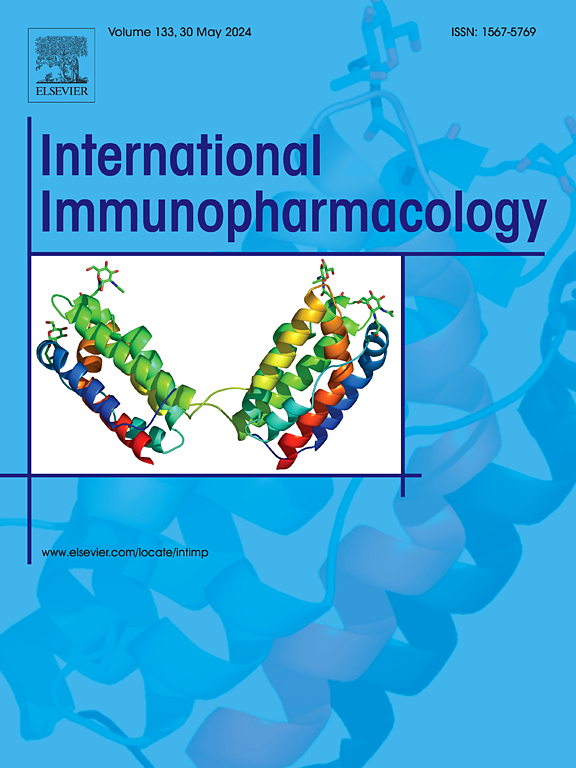Targeting Nav1.5 with DKK678 attenuates NF-κB–driven inflammatory injury in skeletal muscle
IF 4.7
2区 医学
Q2 IMMUNOLOGY
引用次数: 0
Abstract
Skeletal muscle inflammation associated with sepsis has been identified as a critical pathological process contributing to metabolic dysfunction and poor clinical outcomes. Voltage-gated sodium channels (VGSCs) have been implicated in immune modulation; however, their specific roles in skeletal muscle inflammation remain poorly understood. In this study, the VGSC subtype Nav1.5 was investigated as a potential regulator of inflammation, and the therapeutic efficacy of a novel recombinant scorpion peptide, DKK678, was evaluated.
An in vitro model using lipopolysaccharide (LPS)-stimulated C2C12 cells and an in vivo cecal ligation and puncture (CLP) model in septic mice were established. In both models, Nav1.5 expression was significantly upregulated in response to inflammatory stimuli, while Nav1.4 expression remained unchanged. The nuclear factor kappa B (NF-κB) signaling pathway was found to be activated, contributing to increased expression of interleukin-6 (IL-6), tumor necrosis factor-alpha (TNF-α), adhesion molecules (VCAM-1), and gap junction proteins (Cx43). Suppression of VGSC activity using lidocaine resulted in the inhibition of NF-κB phosphorylation and downregulation of inflammatory markers, while the expression of interleukin-10 (IL-10) and interleukin-4 (IL-4) were restored. Tetrodotoxin (TTX) treatment did not replicate these effects, suggesting Nav1.5-specific involvement.
DKK678 was developed through bioinformatic design and molecular docking simulations, which predicted a stronger binding affinity and structural stability with Nav1.5 compared to Nav1.4. These predictions were validated through functional experiments. In vitro, DKK678 treatment dose-dependently inhibited LPS-induced NF-κB pathway activation and reversed abnormal expression of VCAM-1 and Cx43. In vivo, DKK678 significantly ameliorated CLP-induced skeletal muscle damage, suppressed inflammatory cytokine production, and improved tissue histopathology. Furthermore, the structural integrity of immune organs such as the thymus and spleen was preserved in DKK678-treated septic mice, with partial restoration of lymphocyte populations and organ indices. Notably, Nav1.5 expression was downregulated by DKK678, while Nav1.4 expression remained unaffected.
These results demonstrate that Nav1.5 serves as a critical inflammatory modulator in skeletal muscle and immune tissues. Its upregulation was shown to drive NF-κB pathway activation and inflammatory cytokine production. By targeting Nav1.5, DKK678 was able to exert dual protective effects on both skeletal muscle and immune organs under septic conditions. The therapeutic potential of DKK678 was found to be comparable to that of dexamethasone (DEX) at high doses, without altering Nav1.4 expression.
In conclusion, the present study provides new mechanistic insight into the role of Nav1.5 in skeletal muscle inflammation and identifies DKK678 as a promising peptide therapeutic that targets Nav1.5 to suppress NF-κB-mediated inflammatory injury. These findings suggest that Nav1.5 inhibition represents a viable strategy for the treatment of sepsis-associated myositis and related inflammatory disorders.
DKK678靶向Nav1.5可减轻骨骼肌NF-κ b驱动的炎症损伤
与败血症相关的骨骼肌炎症已被确定为导致代谢功能障碍和不良临床结果的关键病理过程。电压门控钠通道(VGSCs)与免疫调节有关;然而,它们在骨骼肌炎症中的具体作用仍然知之甚少。在这项研究中,研究了VGSC亚型Nav1.5作为炎症的潜在调节剂,并评估了一种新型重组蝎子肽DKK678的治疗效果。建立了脂多糖(LPS)刺激C2C12细胞体外模型和脓毒症小鼠盲肠结扎穿刺(CLP)体内模型。在两种模型中,Nav1.5的表达在炎症刺激下显著上调,而Nav1.4的表达保持不变。核因子κB (NF-κB)信号通路被激活,导致白细胞介素-6 (IL-6)、肿瘤坏死因子-α (TNF-α)、粘附分子(VCAM-1)和间隙连接蛋白(Cx43)的表达增加。利多卡因抑制VGSC活性,抑制NF-κB磷酸化,下调炎症标志物,恢复白细胞介素-10 (IL-10)和白细胞介素-4 (IL-4)的表达。河豚毒素(TTX)治疗没有复制这些效果,表明nav1.5特异性参与。DKK678通过生物信息学设计和分子对接模拟开发,预测与Nav1.4相比,与Nav1.5的结合亲和力和结构稳定性更强。这些预测通过功能实验得到了验证。在体外,DKK678剂量依赖性地抑制lps诱导的NF-κB通路激活,逆转VCAM-1和Cx43的异常表达。在体内,DKK678显著改善clp诱导的骨骼肌损伤,抑制炎症细胞因子的产生,改善组织病理学。此外,dkk678处理的脓毒症小鼠胸腺和脾脏等免疫器官的结构完整性得以保留,淋巴细胞群和器官指数部分恢复。值得注意的是,DKK678下调了Nav1.5的表达,而Nav1.4的表达不受影响。这些结果表明,Nav1.5在骨骼肌和免疫组织中是一种关键的炎症调节剂。其上调被证明可驱动NF-κB通路激活和炎症细胞因子的产生。通过靶向Nav1.5, DKK678能够在败血症条件下对骨骼肌和免疫器官发挥双重保护作用。在不改变Nav1.4表达的情况下,DKK678的治疗潜力与高剂量地塞米松(DEX)相当。总之,本研究为Nav1.5在骨骼肌炎症中的作用提供了新的机制,并确定DKK678是一种有前景的肽治疗药物,可靶向Nav1.5抑制NF-κ b介导的炎症损伤。这些发现表明,抑制Nav1.5是治疗脓毒症相关肌炎和相关炎症性疾病的可行策略。
本文章由计算机程序翻译,如有差异,请以英文原文为准。
求助全文
约1分钟内获得全文
求助全文
来源期刊
CiteScore
8.40
自引率
3.60%
发文量
935
审稿时长
53 days
期刊介绍:
International Immunopharmacology is the primary vehicle for the publication of original research papers pertinent to the overlapping areas of immunology, pharmacology, cytokine biology, immunotherapy, immunopathology and immunotoxicology. Review articles that encompass these subjects are also welcome.
The subject material appropriate for submission includes:
• Clinical studies employing immunotherapy of any type including the use of: bacterial and chemical agents; thymic hormones, interferon, lymphokines, etc., in transplantation and diseases such as cancer, immunodeficiency, chronic infection and allergic, inflammatory or autoimmune disorders.
• Studies on the mechanisms of action of these agents for specific parameters of immune competence as well as the overall clinical state.
• Pre-clinical animal studies and in vitro studies on mechanisms of action with immunopotentiators, immunomodulators, immunoadjuvants and other pharmacological agents active on cells participating in immune or allergic responses.
• Pharmacological compounds, microbial products and toxicological agents that affect the lymphoid system, and their mechanisms of action.
• Agents that activate genes or modify transcription and translation within the immune response.
• Substances activated, generated, or released through immunologic or related pathways that are pharmacologically active.
• Production, function and regulation of cytokines and their receptors.
• Classical pharmacological studies on the effects of chemokines and bioactive factors released during immunological reactions.

 求助内容:
求助内容: 应助结果提醒方式:
应助结果提醒方式:


